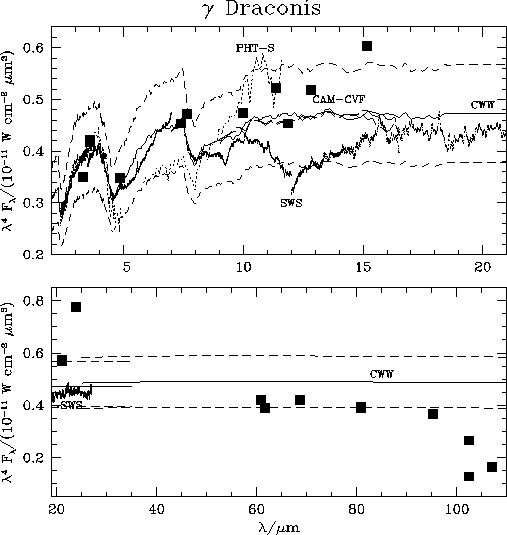Next: World Wide Web and Up: ISO INFO No. 11 Previous: PHOT Interactive Analysis
ISO Cross-Calibrations
Cross calibrations are consistency checks used to ensure that results from different instruments agree to the stated uncertainties. If two instruments give different results, either the true uncertainties are larger than stated, or one or both of them gives a wrong result. These checks are useful because absolute calibration is performed at specific wavelengths where the absolute flux density of reference source(s) is given, and is then extrapolated via models of the source's spectral energy distribution to other spectral ranges of the instrument.
As part of the cross calibration programme (Moneti et al. 1996, & Breitfellner et al. 1997, see http://general-tools.cosmos.esa.int/iso/users/expl_lib/ISO/misc/xcals1mm.php
and http://generaol-tools.cosmos.esa.int/iso/users/expl_lib/ISO/XCAL/HR6705_23f.gif)
analysing data from several sources that have been observed by more than
one ISO instrument, and will present here some results obtained on ![]() Dra (HR6705), a well modeled K5III star that was chosen as a primary
calibrator for PHT and SWS. These results are derived from reductions done
in early 1997 and must be considered preliminary.
Dra (HR6705), a well modeled K5III star that was chosen as a primary
calibrator for PHT and SWS. These results are derived from reductions done
in early 1997 and must be considered preliminary.
At ![]() 100 the absolute flux calibration of CAM, PHT,
and SWS is based primarily on results of the Ground-Based Preparatory
Programme (GBPP, Jourdain de Muizon & Habing 1992, Les Houches Series:
Infrared Astronomy with ISO, p.129) and of the Cohen, Walker, Witteborn et
al.
100 the absolute flux calibration of CAM, PHT,
and SWS is based primarily on results of the Ground-Based Preparatory
Programme (GBPP, Jourdain de Muizon & Habing 1992, Les Houches Series:
Infrared Astronomy with ISO, p.129) and of the Cohen, Walker, Witteborn et
al.

Figure 1. Comparison of ISO observations of ![]() Dra with CWW
composite and with IRAS PSC. Full line: CWW composite and model; thin dashed
lines: CWW composite ± 20% ; dense dots: SWS spectrum; thin dots: PHT-S
spectrum; thick dashed line: CAM-CVF spectrum; squares: PHT-P and C
photometry.
Dra with CWW
composite and with IRAS PSC. Full line: CWW composite and model; thin dashed
lines: CWW composite ± 20% ; dense dots: SWS spectrum; thin dots: PHT-S
spectrum; thick dashed line: CAM-CVF spectrum; squares: PHT-P and C
photometry.
(Cohen et al. 1992a, AJ 104, 1650, Cohen et al. 1992b, AJ 104, 2030, Cohen et al. 1995, AJ 110, 275, henceforth CWW) absolute calibration programme. These two programmes are complementary (early type dwarfs for the GBPP, late-type giants for the CWW), are both tied to the absolute flux of Vega, and are entirely consistent with one another. It follows that calibration consistency among these instruments is implicit: the instruments teams select a few reference stars on which to base their calibration, then check the calibration against those stars and also against other stars in the system. If there is agreement then calibration consistency is satisfied implicitly.
The figure shows PHT-P/S, SWS grating, and CAM-CVF observations of
![]() Dra. In some cases
background observations were also secured and subtracted from the source,
but this source is bright enough at short wavelengths that the background
is negligible. The ISO results are compared to the CWW composite spectrum
(
Dra. In some cases
background observations were also secured and subtracted from the source,
but this source is bright enough at short wavelengths that the background
is negligible. The ISO results are compared to the CWW composite spectrum
(![]() 20 micron) and extrapolation (
20 micron) and extrapolation (![]() 20 micron),
which we use as reference; the dashed lines parallel to the CWW reference
are displaced by
20 micron),
which we use as reference; the dashed lines parallel to the CWW reference
are displaced by ![]() ; all data are presented in a lambda4 Flambda vs. lambda plot in order to show the differences.
; all data are presented in a lambda4 Flambda vs. lambda plot in order to show the differences.
Overall agreement is within ± 20% of the reference, and is within the expectation for the early part of the mission. The largest deviations in the PHT photometry are at 15 and 25 microns - the first filters used in the multifilter sequence - and they suffer from significant drifts, which have been only partially corrected. The PHT-S results show important deviations at the beginning and end of its spectral range; these are ascribed primarily to detector transients, for which no correction has been applied, and partly to the RSRF, which is not finalised. The largest SWS deviation occurs at 10--15 microns and the error has been traced to the RSRF, which at the time of the analysis was determined from laboratory observations, and which is now being improved with on-orbit data. The CAM-CVF results give the best agreement, with deviations being within just a few percent of the reference.
Next: World Wide Web and Up: ISO INFO No. 11 Previous: PHOT Interactive Analysis
Editor: K. Leech